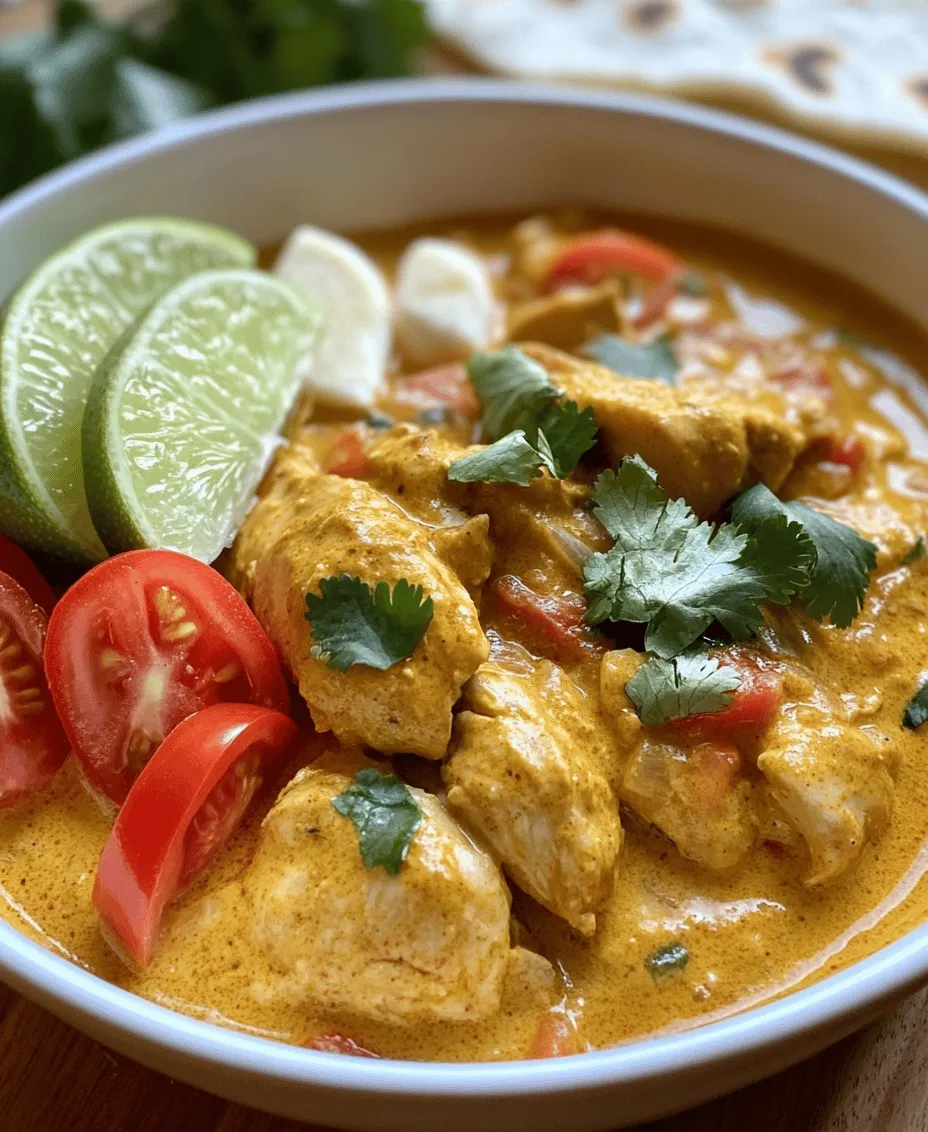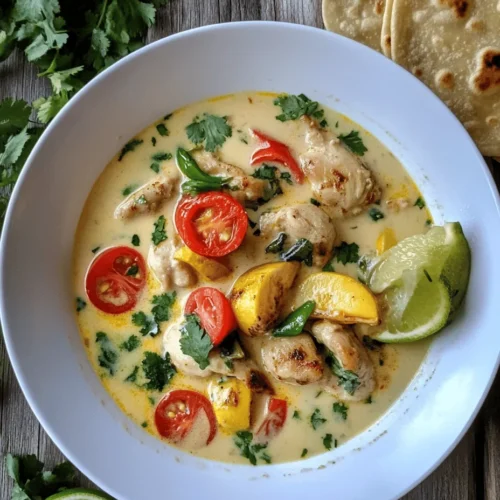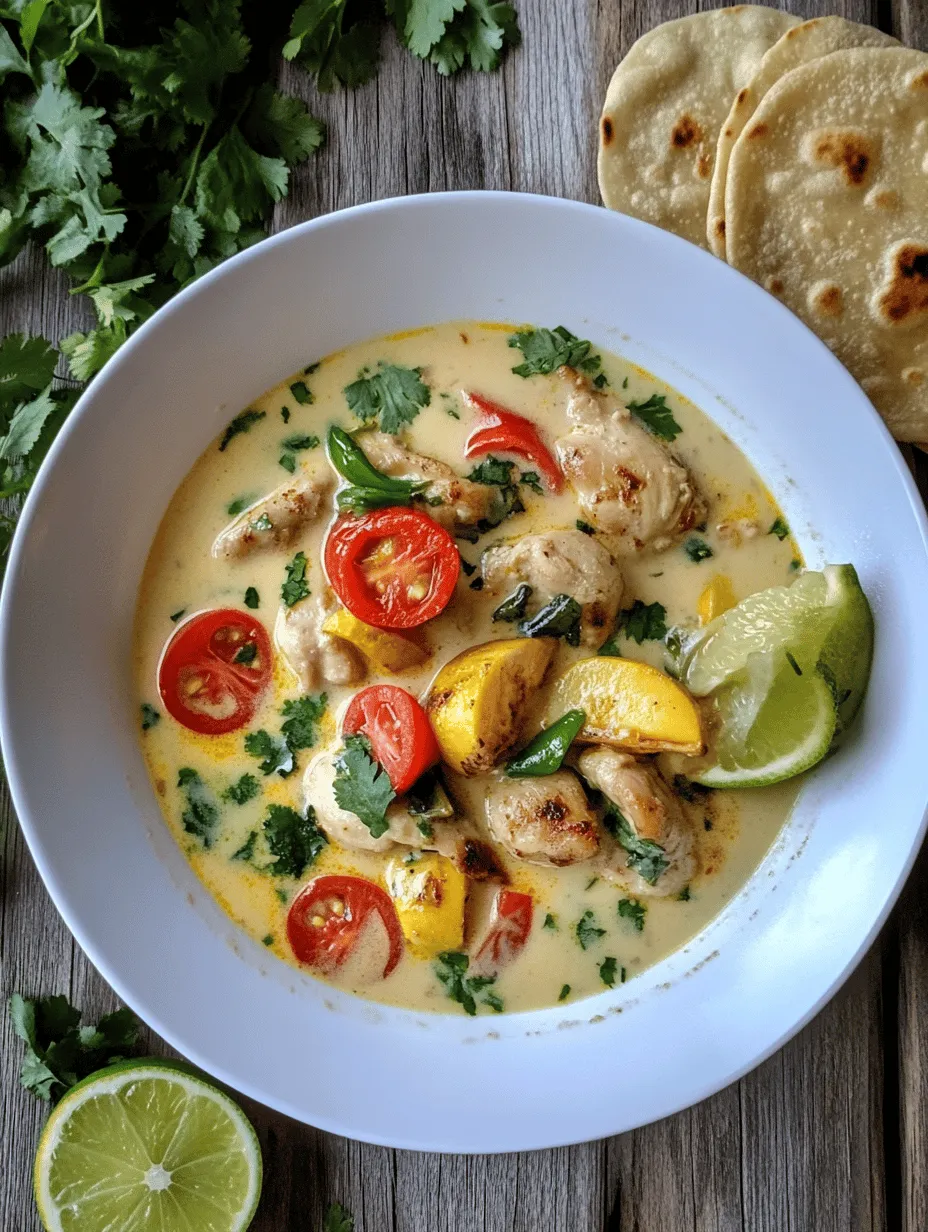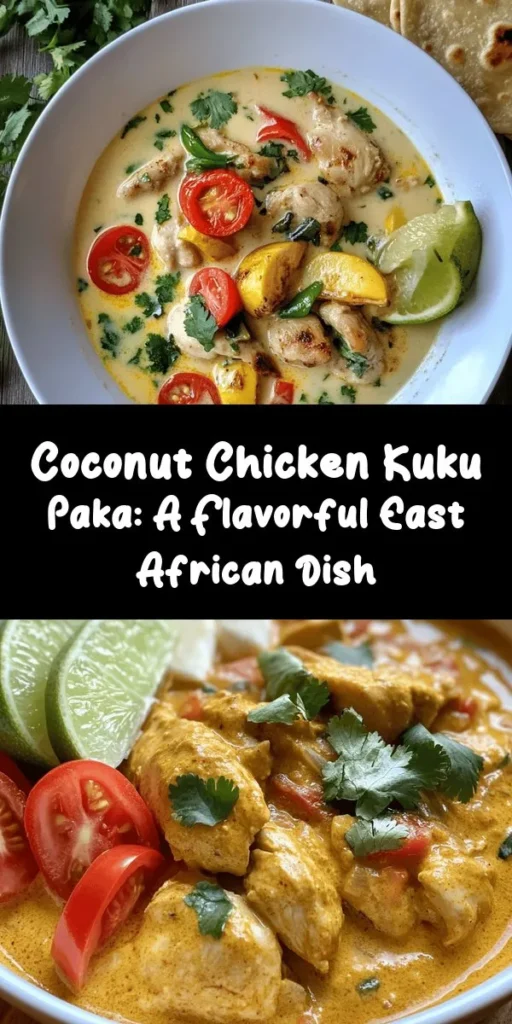Introduction
Kuku Paka, a beloved dish of East African cuisine, offers a rich tapestry of flavors and cultural history that tantalizes the taste buds and warms the heart. This delightful chicken recipe is renowned not only for its delicious taste but also for its deep-rooted significance in the culinary traditions of countries like Kenya and Tanzania. The dish marries succulent chicken with the creamy richness of coconut milk, creating a unique blend that speaks to the abundant culinary resources of the region.
The key to a successful Kuku Paka lies in its harmonious combination of fresh ingredients and vibrant spices. Coconut milk, a staple in many East African dishes, lends a luscious texture and a subtle sweetness that perfectly complements the savory elements of the chicken and spices. This fusion not only makes the dish flavorful but also showcases the influence of coastal cuisine, which is heavily inspired by Indian and Arab culinary practices.
Using fresh, high-quality ingredients is paramount in creating an authentic Kuku Paka. Traditional cooking methods, often passed down through generations, add layers of flavor that are hard to replicate with shortcuts. The process of preparing this dish is as much about the journey as it is about the final product, encouraging cooks to embrace the art of cooking with love and care.
Understanding Kuku Paka
Kuku Paka can be defined as a coconut chicken stew, characterized by its creamy coconut sauce and aromatic spices. The term “Kuku” refers to chicken in Swahili, while “Paka” translates to “to smear” or “to spread,” aptly describing the way the sauce envelops the chicken. This dish has become a staple in East African households and restaurants, beloved for its comforting flavors and ease of preparation.
The origins of Kuku Paka can be traced back to the coastal regions of East Africa, particularly along the shores of the Indian Ocean. The blend of spices and cooking techniques reflects the region’s history of trade and cultural exchange, where flavors from India, Arab countries, and indigenous African traditions converge. In Kenya, Kuku Paka is often served at gatherings and celebrations, symbolizing hospitality and community. In Tanzania, variations may include the addition of local vegetables and spices, showcasing the adaptability of this versatile dish.
Cultural significance is woven into the fabric of Kuku Paka, as it represents the communal nature of East African dining. Meals are often shared among family and friends, and Kuku Paka is no exception. Its ease of preparation and the ability to scale up for larger gatherings make it a preferred choice for festive occasions and everyday meals alike.
The Health Benefits of Kuku Paka
Beyond its mouthwatering flavors, Kuku Paka offers a range of health benefits that make it a nutritious option for those looking to enjoy a well-rounded meal. At the heart of this dish is chicken, a lean protein source that supports muscle growth and repair. Chicken is also rich in essential nutrients like B vitamins, which are crucial for energy production and overall health.
Another star ingredient in Kuku Paka is coconut milk, celebrated for its health benefits. This creamy substance is a source of healthy fats, particularly medium-chain triglycerides (MCTs), which are known to support heart health and may even aid in weight management. The lauric acid found in coconut milk has antimicrobial properties, contributing to overall immune system function.
Additionally, the spices used in Kuku Paka, such as turmeric and ginger, are renowned for their health-promoting properties. Turmeric, with its active compound curcumin, is recognized for its anti-inflammatory and antioxidant effects. Ginger, on the other hand, is known to aid digestion and may help boost the immune system. Together, these spices not only enhance the flavor of the dish but also contribute to a healthier profile.
Essential Ingredients for Kuku Paka
To recreate the authentic taste of Kuku Paka, it is important to gather the right ingredients. Each component plays a crucial role in the overall flavor and texture of the dish. Below is a detailed description of the essential ingredients required for preparing Kuku Paka.
Chicken: Importance of Choosing the Right Cut
The foundation of Kuku Paka is, of course, the chicken. When selecting chicken for this dish, it is essential to choose cuts that will stay moist and tender during cooking. Bone-in, skin-on chicken thighs are often preferred for their rich flavor and juiciness. However, for those looking for a leaner option, boneless, skinless chicken breasts can also work well. Whichever cut you choose, ensure that it is fresh and of high quality for the best results.
Coconut Milk: Types and Brands to Consider
Coconut milk is what gives Kuku Paka its signature creaminess and depth of flavor. When shopping for coconut milk, you will typically find two types: canned coconut milk and boxed coconut milk. Canned coconut milk is thicker and richer, making it ideal for creating a luscious sauce. Look for brands that contain only coconut and water, avoiding those with added preservatives or stabilizers.
For an authentic experience, opt for full-fat coconut milk, which provides the creaminess needed for this dish. Some popular brands include Chaokoh, Aroy-D, and Thai Kitchen. If you prefer a lighter option, you can use light coconut milk, but keep in mind that it may alter the texture and richness of the final dish.
Spices: Overview of Curry Powder, Turmeric, and Their Flavor Profiles
The spices used in Kuku Paka are what truly elevate the dish, providing both warmth and complexity. A good quality curry powder is essential, as it brings together a variety of spices, including cumin, coriander, and fenugreek, creating a well-rounded flavor. The exact blend can vary by brand, so it may be worth trying a few different ones to find your favorite.
Turmeric is another key spice that not only adds vibrant color but also contributes to the dish’s health benefits. Its warm, earthy flavor complements the sweetness of the coconut milk beautifully. Fresh ginger adds a zesty kick, enhancing the overall taste profile of Kuku Paka. For an extra layer of flavor, consider adding garlic and onions, which are often sautéed at the beginning of the cooking process to create a flavorful base.
Using fresh spices is vital for achieving the best flavor in Kuku Paka. If possible, opt for whole spices that you can grind yourself, as this will provide a more intense aroma and taste. Additionally, consider incorporating fresh cilantro or parsley as a garnish to add brightness and freshness to the finished dish.
By carefully selecting your ingredients and understanding their significance, you can create a truly remarkable Kuku Paka that embodies the essence of East African cuisine. The next steps will guide you through the preparation and cooking process, ensuring that you achieve a flavorful and satisfying result.

Fresh Produce: The Role of Onions, Tomatoes, Garlic, Ginger, and Green Chilies
In the heart of Kuku Paka lies a medley of fresh produce that elevates the dish from simple chicken to a delightful culinary experience. The combination of onions, tomatoes, garlic, ginger, and green chilies not only adds depth of flavor but also creates a vibrant and aromatic base for the coconut chicken.
Onions are essential for building the foundation of the dish; they caramelize beautifully, adding sweetness and complexity. When sautéed until golden, they create a fragrant backdrop for the other ingredients.
Tomatoes bring acidity and moisture, balancing the richness of coconut milk. Their juiciness enhances the overall sauce, ensuring each bite is bursting with flavors.
Garlic and ginger are staples in East African cuisine, imparting warmth and a hint of spice. Together, they create a fragrant paste that infuses the chicken with their aromatic qualities during the marination process.
Green chilies introduce a gentle heat that can be adjusted based on personal preference. They provide a fresh, zesty kick, making Kuku Paka a dish that appeals to a wide range of palates.
Optional Ingredients: Cultural Implications of Serving with Ripe Bananas and Chapati
While Kuku Paka can stand alone as a hearty meal, it is often served with traditional accompaniments like ripe bananas and chapati. Ripe bananas, with their natural sweetness, complement the spiciness of the dish, creating a delightful contrast. This combination is not only popular for its flavor pairing but also reflects the cultural practices of East African communities, where meals often incorporate diverse flavors and textures.
Chapati, a soft flatbread, is ideal for scooping up the creamy coconut sauce. It serves as a versatile utensil, allowing diners to fully enjoy the rich flavors of the Kuku Paka. The inclusion of these ingredients highlights the communal aspect of dining in East Africa, where sharing food is a cherished tradition.
Step-by-Step Guide to Making Kuku Paka
Detailed Marination Process and Its Significance
Marination is a critical step in preparing Kuku Paka, as it allows the chicken to absorb the robust flavors of the spices and aromatics. To marinate the chicken:
1. Prepare the Marinade: In a large bowl, combine yogurt, minced garlic, grated ginger, turmeric, coriander, cumin, and salt. This mixture not only tenderizes the chicken but also infuses it with a rich flavor profile.
2. Marinate the Chicken: Add the chicken pieces to the marinade, ensuring they are well-coated. Cover the bowl and refrigerate for at least 1-2 hours, or ideally overnight. The longer the marination, the more flavorful the chicken will become.
Techniques for Sautéing and Building the Sauce Base
Creating the perfect sauce for Kuku Paka requires careful sautéing to develop flavors:
1. Sauté the Onions: In a large skillet or pot, heat oil over medium heat. Add the sliced onions and cook until they are golden brown, stirring frequently to prevent burning. This step is crucial as it builds the flavor base of the dish.
2. Add Garlic, Ginger, and Green Chilies: Once the onions are caramelized, stir in the minced garlic, grated ginger, and chopped green chilies. Sauté until fragrant, about 1-2 minutes.
3. Incorporate Tomatoes: Add the diced tomatoes to the pan, stirring until they soften and break down, creating a rich sauce. This mixture will serve as the flavorful foundation for the chicken and coconut milk.
Cooking Tips for Achieving the Right Consistency with Coconut Milk
The coconut milk is the star ingredient that brings creaminess and a subtle sweetness to Kuku Paka. To achieve the right consistency:
1. Add Coconut Milk Gradually: Once the tomato mixture is well combined, pour in the coconut milk slowly, stirring continuously. This helps to ensure a smooth blend without curdling.
2. Simmer Gently: Allow the sauce to simmer on low heat, stirring occasionally. This gentle cooking process allows flavors to meld and prevents the coconut milk from separating.
3. Adjust Consistency: If the sauce is too thick, add a little water or chicken broth to reach the desired consistency. It should be rich and creamy but not overly heavy.
Adjusting Spice Levels to Suit Personal Taste
The beauty of Kuku Paka lies in its adaptability to different taste preferences. To adjust spice levels:
– Taste as You Go: Always taste the sauce before adding additional spices. This allows you to control the heat and ensure it aligns with your palate.
– Add More Chilies or Spices: If you prefer a spicier dish, increase the number of green chilies or add a pinch of cayenne pepper.
– Balance with Sweetness: If the spices become too overwhelming, a small amount of sugar or honey can balance the heat and enhance the overall flavor.
Serving Suggestions for Kuku Paka
Kuku Paka is best enjoyed with traditional accompaniments that enhance its flavors and create a well-rounded meal.
Traditional Accompaniments: Ripe Bananas and Chapati
As mentioned earlier, serving Kuku Paka with ripe bananas and chapati is a culinary tradition. The sweetness of the bananas complements the savory chicken, while the chapati provides a delightful way to savor every bite of the sauce.
Creative Ways to Serve Kuku Paka: Rice, Ugali, or Naan
For those looking to switch things up, Kuku Paka pairs wonderfully with various side dishes:
– Rice: Serve over a bed of fluffy basmati or jasmine rice to soak up the delicious sauce. The rice acts as a blank canvas, allowing the flavors of the dish to shine.
– Ugali: This Kenyan staple, made from maize flour, offers a hearty accompaniment to the dish. Its dense texture balances the creaminess of Kuku Paka.
– Naan: For a fusion twist, serve with warm naan bread. This Indian flatbread is perfect for scooping up the coconut chicken and adds an interesting layer to the meal.
Presentation Tips for an Appealing Dish
When serving Kuku Paka, presentation can elevate the dining experience:
– Garnish: Sprinkle freshly chopped cilantro or parsley over the dish for a pop of color and freshness.
– Serve in a Beautiful Dish: Use a decorative serving bowl to showcase the vibrant colors of the chicken and sauce.
– Plate with Style: If serving with rice or chapati, neatly arrange the side dishes on the plate to create an inviting presentation.
The Culinary Journey of Kuku Paka
Kuku Paka is more than just a meal; it represents the rich culinary heritage of East Africa. Many people have fond memories associated with this dish, often recalling family gatherings where Kuku Paka was the star of the table.
Anecdotes from those who have experienced Kuku Paka often highlight its warmth and the comfort it provides. It is a dish that fosters connections, as families and friends gather around the table to share stories and laughter.
In recent years, Kuku Paka has gained popularity in restaurants across the globe, celebrated for its unique flavors and comforting qualities. Chefs have embraced this dish, often adding their personal twist, thus adapting it for modern tastes while preserving its traditional roots.
Conclusion
Making Kuku Paka is a delightful journey into the heart of East African cuisine. The combination of tender chicken, aromatic spices, and creamy coconut milk creates a dish that is not only delicious but also full of cultural significance.
As you explore the joys of cooking and sharing Kuku Paka, you participate in preserving a traditional recipe that has been cherished for generations. Embracing the culinary heritage of East Africa opens doors to a world of flavors, inviting you to connect with family, friends, and cultures.
So, gather your ingredients, don your apron, and embark on this culinary adventure. Enjoy the process of making Kuku Paka, and savor the moments spent around the table, as you share this delightful dish with loved ones.



